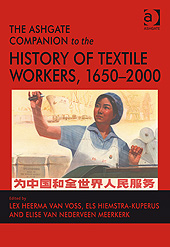People have spun yarn and woven fabrics through thousands of years. It was a production which was predominantly carried out as homework or crafts. During the 1700s, though, a revolutionary process was started in England: work became concentrated in large units, equipped with machines powered at first by water wheels and later by steam engines. The industrial form of production spread from England to the European mainland and from there eventually to the rest of the world.
Industrialization changed not just production processes but also working conditions and the composition and living conditions of the labourers. Men, women and children were recruited to the factories in their thousands. Cities grew. Traditional forms of organizing and thinking about work became obsolete and new organizations and ideas were created. This is the story that is told in a new publication: “The Ashgate Companion to the History of Textile Workers, 1650-2000″. The book, which is 860 pages, is the result of an international research collaboration, launched at the initiative of the International Institute of Social History in Amsterdam.
Textile industry is interesting because it was where industrialization began. But also because it is a global phenomenon. The book’s first part consists of articles on textile production and textile workers’ history in 20 different countries worldwide – including Denmark. With due respect for national differences, the story is told from the times of pre-industrial production, throughout the industrial breakthroughs and peaks until today, where the textile industry is being phased out in the areas where it started: Western Europe and the USA. But textile industry is still, indeed, a reality. On a global scale, there is probably more people employed in the textile industry than ever before in history. Now its largest parts however are centred in Asia, especially in China. The second part of the book consists of a series of thematic articles where the authors draw comparisons across countries. For example, there are themes of globalization, labour recruitment, work organization and the gender division of labour.

I have contributed two articles. The first deals with the history of textile work in Denmark. In global perspective, Denmark has never played any significant role as a textile producer. On the contrary, the Danish industry almost exclusively produced for the domestic market, while the technology used was imported from England, Germany and other major European textile nations. But Denmark, however, was a pioneer in another area, namely in the way the workforce organized itself, which led to a relatively early development of highly institutionalized and regulated industrial relations. Something, that became the basis for the subsequent development of the welfare state. This is the perspective in the article which is titled “Denmark: the textile industry and the formation of modern industrial relations.”
My second contribution is for the second part of the book, for which I have written an article entitled “Institutions in textile production: guilds and trade unions” to compare the development such institutions in different countries in a global perspective. This article is based on the other national overviews, in conjunction with general theories of unionisation. As the national overviews are written from quite different perspectives, it is not at comparative work in the strict sense. Nevertheless, I think there are grounds for some cautious conclusions, including that the role of the state and the relationship between the classes is probably more important than differences in production methods and technology, in explaining the variations in scope and aim of labour organizations.
As the title indicates, the book is published by Ashgate publishers. The complete table of contents, as well as information about price etc., can be found on the publisher’s website.
(Cross-posted from blog.nyeretid.dk)